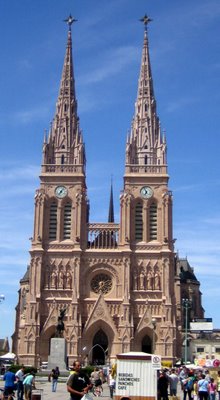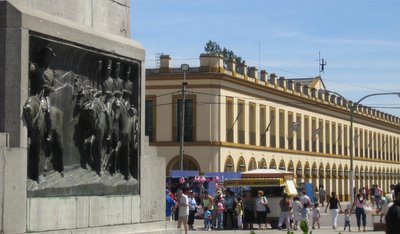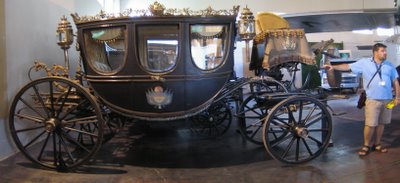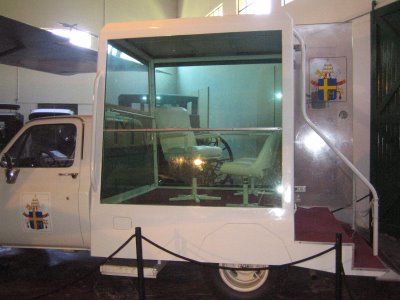Luján , Argentina

Rising 300 feet from the flat North Pampas countryside, Lujan’s Basílica de Nuestra Señora de Luján honors the patron saint of Argentina, Uruguay, and Paraguay. Click on this and all pictures to enlarge.
Luján, Argentina
Visited November 27, 2005
On Sunday, the tour headed out of Buenos Aires to sample the North Pampas countryside. Our first stop was about 35 miles away at the cathedral (really basilica) city of Luján, named for conquistador Pedro Luján, whom the Indians killed here in a 1536 skirmish. Every October, up to a million Argentine pilgrims walk the same route from BA to Luján as part of a religious festival. Even in November, we saw plenty of pilgrims here: 5 million people visit this city of about 70,000 every year. It seemed like that many were crowding the basilica for late Sunday morning mass.
Argentines call Luján La Capital de la Fe, the Capital of the Faith. Our Lady of Luján serves as the patron saint of Argentina as well as Uruguay and Paraguay – three very heavily Catholic countries. Judging from the wares of the many merchants who lined the path from the parking lot to the Basilica, she’s also the patron saint of religious kitsch – but Luján has lots of competition for that title, including St. Peter’s in Rome. (Do you still have those John-Paul II bottle openers I gave out for Christmas one year? You know who you are and you never know when I may drop in for a visit. Better shine them up!)
The Many Shrines to Nuestra Senora de Luján
The story of the shrine’s founding starts in 1630 with a caravan to Santiago del Estero. Two days out of Buenos Aires, a team of oxen become paralyzed while attempting a crossing of the River Lujan. Boxes get unloaded one-by-one until the oxen finally move. When the culprit package is opened, its contents reveal a terra-cotta statue of the Immaculate Conception about 18 inches tall. Figuring they’ve just received a message from on high, the caravan deposits the statue at the house of Don Rosendo de Oramas, about 15 miles away. Rosendo eventually builds a small chapel to accommodate the hordes from Buenos Aires traipsing out to see the miraculous icon. A village to serve the religo-touristas grows around the chapel; (the bottle opener has not been invented yet); the settlement is declared the town of Luján in 1755.
As the number of visitors increases, authorities decide to build a larger church. In 1685 the Chapel of Montalbo, apparently a simple adobe building, is completed. It takes its name from a priest who was cured of his asthma by the statue and stayed to become the pastor/builder. (As we shall see, the statue is quick to cure potential developers (does Donald Trump need a patron saint?) As crowds continue to increase, a later attempt to replace the adobe chapel meets with disaster as the new building collapses due to an engineering miscalculation. (Apparently the statues miraculous powers are confined to biology; physics is another story.)

If you are used to seeing grey European cathedrals, the clean stone from Colón is refreshing
Later, a competent architect named Don Juan de Lezica y Torrezur is cured of his asthma by the virgin, and from 1754-1763 successfully completes a structure on the site of the current sanctuary. (Apparently there is breathing room in Luján.)
Nuestra Senora’s Boswell
All goes well for another century or so until a French priest, Jorge M. Salvaire, is assigned to the parish in the 1880s. (Fr. Salvaire first visits Luján in 1871 while fleeing the yellow fever attacking Buenos Aires). On a later trip to convert Indians, he contracts smallpox and promises to write the history of the Virgin of Lujan and build an edifice to support her cult if he survives. An Indian immediately shows up and helps him recover. (We had an Inca-ling that would happen.)
Salvaire’s two volume history spreads knowledge of the cult far and wide and creates demand for the French neo-gothic Basilica which stands tall (over 300-foot-high twin towers) in the flat Pampas today. (Fr. Salvaire starts the building but, unfortunately, does not live to see its completion. No wonder, it takes over 45 years to complete in 1937.)

Four statues stand on each side of the Rose Window and four more wrap around to the other side of the twin towers --16 in all -- representing the twelve apostles and four evangelists. Can you find St. Peter holding the keys to heaven?
The French architect Ulderico Courtois creates a thin, acute-angled design using pink stone from the river border town of Colón.
Inside, we found the basilica’s 100-yard-long nave jammed with Argentines participating in varying degrees in one of the eight Sunday masses. Around the edges swirled masses of tourists (that would be us) circling the basilica in an attempt to get to the small statue at its center. (We didn’t make it to the statue due to the crowds; ditto for the collection of virgin statues in the crypt below.)
Plaza Belgrano – the other Luján statue

Plaza Belgrano view of the museum complex
In front of the Basilica, flanked by the arcaded museum complex, is the sparsely furnished Plaza Belgrano. OK, it’s empty of permanent structures except for the requisite Argentine military statue (even in a city made famous by religion). This equestrian statue honors Manuel Belgrano, sort of a combination of our Washington, Jefferson, and Betsy Ross. A general during the Argentine war of independence, he designed the country’s flag (which, unfortunately, is not at all like the Texas flag). He went on to help with the Declaration of Independence in 1816. He was less successful in helping with the new constitution and was nearly laughed out of the chamber when he proposed a constitutional monarchy headed by the Incas. (More typical was General Roca --his graffiti-smeared statue protects Bariloche; he made it to bronze by crowning natives with more violent means).
History has generally been kinder to Belgrano than life; the ma
 ny harsh campaigns ruined his health and he died in obscurity and poverty at age 50. Besides his statue here, he appears on the Argentine 10 Peso note; Argentines celebrate the anniversary of his death each year as their flag day. But not all Belgrano memorials have been as successful, trivia buffs will remember the Brits sank the only Argentine cruiser, the ARA General Belgrano, nee USS Phoenix, resulting in the most serious loss of life during the 1982 Falklands/Islas Malvinas War.
ny harsh campaigns ruined his health and he died in obscurity and poverty at age 50. Besides his statue here, he appears on the Argentine 10 Peso note; Argentines celebrate the anniversary of his death each year as their flag day. But not all Belgrano memorials have been as successful, trivia buffs will remember the Brits sank the only Argentine cruiser, the ARA General Belgrano, nee USS Phoenix, resulting in the most serious loss of life during the 1982 Falklands/Islas Malvinas War. General Belgrado is all spruced up here but had a tough life of campaigning and died in poverty and obscurity at age 50
Movin’ on to the Complejo Museográfico
The Complejo Museográfico Enrique Udaondo (the museum complex is named for a former director) repopulates the old cabildo (town hall) and viceroy palace buildings with several museums. Here’s a photo of the long arcarde, added during an 1918 restoration:

The 1918 Arcade added to the old Lujan Cabildo to create the museum complex
Beyond the arcade lies the Museo de Transporte which we visited. At the entrance is this recreation of the type of cart used by Argentines to tame their pampas around 1815, about the time they were throwing off the Spanish yoke themselves:

The wagon that tamed the Pampas
The museum abounds in well preserved carriages…

…including this fancy carriage which belonged to General Bartolomé Mitre, who served as president of Argentina during the time of the American civil war:

The carriage is on the left; on the right was our Buenos Aires guide, the ebullient Pedro Rafael Porqueras.
One of the museum’s showpieces is the British-made La Porteña, the first locomotive used in Argentina; it traveled from what is today the Buenos Aires opera house to the port (hence its name) from 1857 through1891.

Army Surplus: La Porteña travelled about 10K as the first train in Argentina -- The Brits built it to help in the Crimean war which ended before it could get there
What most interested me was the German Dornier hydroplane, the first plane to fly trans-Atlantic from Argentina, in this case, to Spain in 1926. Note the crank to start the engine!

Here’s a somewhat wider view of the monster (click on it to enlarge):

Transatlantic planes were probably more uncomfortable then than even the smashed-seat cabin that American Airlines used to crate us from Buenos Aires back to Miami at the end of our trip (but who’s complaining?) Here’s a map of the many hops needed in 1926 to get the seaplane to Spain:

Our final museum picture is that of the popemobile, used when John Paul II came to Argentina to try to convince the military dictatorship to end the 1982 Falklands/Islas Malvinas War.
Horsin’ around
After a crowded Sunday morning in a church town, we traveled to the North Pampas La Rosada ranch for an Argentine barbeque under this 300-year-old oak tree:

Besides food and wine, we received a demonstration of the accouterments of the Argentine Gaucho. Here we learn about the many layers of saddle blankets.

At the end of the demonstration, Houston’s biggest animal lover got to pump the flesh:

Fellow Travelers
Finally we took our only tour group picture and got back on the bus to Buenos Aires; here’s us, 31 of our closest friends, and a highly unused soccer ball:

Haven’t had enough – check out the Lujan pictures on the cutting room floor.
----------------------------------------------------------------------
Typical bottom-of-the-blog stuff
Internet Explorer users, want to see more? Then download the free Firefox browser by clicking here – these pages display better in Foxfire and its more secure than that Microsoft thing.
Where are we now? Click here for an interactive map of Argentina.
----------------------------------------------------------------------
Ignore these links unless you want to see other bloggers views on:
Travel
Lujan
Argentina
Labels: vacation travel



0 Comments:
Post a Comment
<< Home